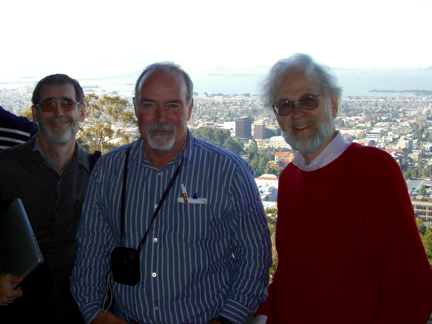
The idea that would result in NEXT (as a HPXe-TPC experiment) was proposed to A. Bettini, then director of the LSC, circa 2008 by J.J. Gómez Cadenas. Shortly after, he heard that Dave Nygren, the famous inventor of the TPC technology was also interested in developing an experiment based on an HPXe TPC. Knowing that, JJ called Dave, and invited him to visit Spain and join the incipient NEXT collaboration. Dave accepted, and they started a collaboration and friendship that has lasted for more than 12 years. The third major player in the early story of NEXT was the late Jame White, at the time possibly the greatest World expert in high-pressure noble gas chambers. Dave referred to White as “my pal James”, and JJ referred to him as “Saint James”, since his help with the construction of the first IFIC prototype, NEXT-DEMO was essential for the development of the project.
The key elements that made NEXT a powerful ββ0v detector were: a) the use of electroluminescence, proposed by Dave, which permits reaching energy resolutions below 1% FWHM (DBDM, the prototype that Dave built at LBNL, reached resolutions in the Cs-137 peak that would extrapolate to 0.5% FWHM at the energies of the ββ0v decay) and b) the adoption of a pixelized tracking plane, based in SiPMs, an idea proposed by JJ, which allows the powerful reconstruction of electron tracks. A few years later, Dave would propose the ground-breaking idea of using Single Molecule Fluorescence Imaging, SMFI, to detect the Ba2++ ion produce in the ββ0v decay of xenon, a technique, that, if demonstrated, would make possible a NEXT detector (which we call NEXT-BOLD) capable of fully suppressing the background, and thus, with a huge discovery potential.
Back to the present
Due to the extreme rareness of the neutrinoless double beta decay searches, two ingredients have crucial importance: energy resolution and background suppression. Concerning the first one, the NEXT-White detector (2015-2021) showed a superb energy resolution below 1% FWHM in the Qββ. On the other hand, the addition of the Richardson-Lucy deconvolution algorithm within the reconstruction chain provides us with a highly defined representation of the events, which allows us to achieve an impressive signal/background discrimination.
Currently, the NEXT-100 construction has been completed and the detector is currently taking data with Xenon. Comprising an intermediate state before the tonne-scale generation, it is meant to understand technical solutions at large scale, validate the background model, and provide an additional physics measurement for ββ0ν searches, among other issues.
However, the null results in the ββ0ν search by current-generation experiments point towards sensitivities that can only be achieved with both huge exposures and quasi-background-free experiments. Within the NEXT program, two different approaches will try to fulfill these conditions:
- NEXT-HD will follow NEXT-100, increasing by a factor of 10 its fiducial mass and implementing some changes in the design: it will be a symmetric device comprising two twin back-to-back TPCs.
- The NEXT-Bold program will also include a barium tagging technique, that would allow to detect the presence of Ba++ ions, the daughter nuclei in 136-Xe decays. This achievement, in combination with an excellent energy resolution, would convert NEXT into an almost background-free experiment.
